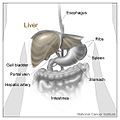Falciform ligament: Difference between revisions
CSV import |
CSV import |
||
| Line 31: | Line 31: | ||
[[Category:Surgery]] | [[Category:Surgery]] | ||
{{dictionary-stub1}} | {{dictionary-stub1}} | ||
<gallery> | |||
File:Liver_and_nearby_organs.jpg|Liver and nearby organs | |||
File:Gray984.png|Gray's Anatomy illustration of the liver | |||
File:Gray1039.png|Gray's Anatomy illustration of the falciform ligament | |||
File:Slide2UC.JPG|Falciform ligament | |||
</gallery> | |||
Latest revision as of 04:49, 18 February 2025
Falciform ligament is a thin, crescent-shaped ligament that attaches the liver to the anterior abdominal wall and the diaphragm. It is a remnant of the umbilical vein and is present in the human body from birth. The falciform ligament is visible on the surface of the liver as a thin, white line.
Anatomy[edit]
The falciform ligament is a double layer of peritoneum, extending from the anterior abdominal wall and the diaphragm to the liver. It separates the right and left lobes of the liver and attaches the liver to the anterior abdominal wall. The falciform ligament contains the round ligament of the liver (ligamentum teres hepatis), which is a fibrous remnant of the umbilical vein.
Function[edit]
The primary function of the falciform ligament is to stabilize the position of the liver within the abdomen. It does not have a significant role in the physiology of the liver.
Clinical significance[edit]
In some surgical procedures, the falciform ligament may be cut to allow better access to the liver or other structures in the abdomen. It can also be used in surgical reconstructions.
See also[edit]
References[edit]
<references />







